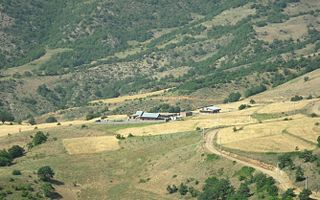| Qeshlaq-e Karanlu قشلاق كرانلو | |
|---|---|
| village | |
| Coordinates: 38°55′48″N46°38′16″E / 38.93000°N 46.63778°E Coordinates: 38°55′48″N46°38′16″E / 38.93000°N 46.63778°E | |
| Country | |
| Province | East Azerbaijan |
| County | Khoda Afarin |
| Bakhsh | Minjavan |
| Rural District | Minjavan-e Gharbi |
| Time zone | IRST (UTC+3:30) |
| • Summer (DST) | IRDT (UTC+4:30) |
Qeshlaq-e Karanlu (Persian : قشلاق كرانلو, also Romanized as Qeshlāq-e Karānlū; also known as Karānlū and Kārvānlū) [1] is a village in Minjavan-e Gharbi Rural District, Minjavan District, Khoda Afarin County, East Azerbaijan Province, Iran. At the 2006 census, its existence was noted, but its population was not reported. [2]

Persian, also known by its endonym Farsi, is one of the Western Iranian languages within the Indo-Iranian branch of the Indo-European language family. It is a pluricentric language primarily spoken in Iran, Afghanistan and Tajikistan, Uzbekistan and some other regions which historically were Persianate societies and considered part of Greater Iran. It is written right to left in the Persian alphabet, a modified variant of the Arabic script.

Minjavan-e Sharqi Rural District is a rural district (dehestan) in Minjavan District, Khoda Afarin County, East Azerbaijan Province, Iran. At the 2006 census, its population was 4,378 in 931 families. The rural district has 36 villages.

Minjavan District is a district (bakhsh) in Khoda Afarin County, East Azerbaijan Province, Iran. The District has no cities and its capital is Asheqlu village. The District has three rural districts (dehestan): Dizmar-e Sharqi Rural District, Minjavan-e Gharbi Rural District, and Minjavan-e Sharqi Rural District.
In the wake of White Revolution (early 1960s) a clan of Mohammad Khanlu tribe, comprising 40 households, used Qeshlaq-e Karanlu as their winter quarters. [3]

The White Revolution or the Shah and People Revolution was a far-reaching series of reforms in Iran launched in 1963 by Shah Mohammad Reza Pahlavi and lasted until 1979. Mohammad Reza Shah’s reform program was built especially to weaken those classes that supported the traditional system. It consisted of several elements, including land reform, sale of some state-owned factories to finance this land reform, construction of an expanded road, rail, and air network, a number of dam and irrigation projects, the eradication of diseases such as malaria, the encouragement and support of industrial growth, enfranchisement of women, nationalization of forests and pastures, formation of literacy and health corps for rural isolated areas, and institution of profit sharing schemes for workers in industry. In the 1960s and 1970s the shah sought to develop a more independent foreign policy and established working relationships with the Soviet Union and eastern European nations. In subsequent decades, per capita income for Iranians skyrocketed, and oil revenue fueled an enormous increase in state funding for industrial development projects.

Mohammad Khanlu (Moḥammad-Ḵānlū) is one of the six major Tribes of Arasbaran. It is a Turkicized Kurdish tribe dwelling for the most part in the Arasbaran region, in East Azerbaijan Province of Iran. Its summer quarters were around Marzrud and its winter quarters were around Heydarkanlu village of Khoda Afarin County. According to A. Lampton, in Arasbaran the pasturage belonged to Khans, who also owned arable land in winter quarters.








